Westerborkpad
The Westerborkpad is a 342-kilometer hiking trail in the Netherlands . If you follow the path along the railroad tracks, you can see the route on which more than 100,000 deported Jews were brought by train from Amsterdam to the Westerbork transit camp during the German occupation of the Netherlands from 1940 to 1945 . The great majority of these people were deported from Westerbork to extermination camps and murdered .
History and description
The initiative to set up this official hiking trail came from the Dutchman Jan Dokter, who lost twelve family members to the Holocaust in 1943 and 1944 . Eight of them were murdered in Auschwitz and four in Sobibor , including his four-year-old cousin. He was eight years old at the time and was not deported because he had a non-Jewish father. The twelve people came from his mother's Jewish family, Pakkedrager. When his mother found out about the death of her relatives after the war, she became mentally ill.
Dokter came up with the idea for the hiking trail in 2008 after walking it privately for four days in 2005 as a 70-year-old in memory of his relatives who had been killed: "Iedereen loopt naar Santiago, maar nog nooit was iemand op dit idee gekome." runs to Santiago, but no one had come up with this idea. ”) At the suggestion of the director of the Westerbork memorial site, he created a brochure describing the route, the route of which he himself had worked out. In January 2012 the path was officially opened as a “hiking and reflection route”. Due to its great success, the third edition of the hiking brochure was published in 2017 in cooperation with the Wandelnet Foundation . The official sponsors of the project are the Kamp Westerbork Memorial and the Koninklijke Wandel Bond Nederland (KWBN) in cooperation with the Kenniscentrum Groen en Handicap .
The path is signposted with its own red and blue markings with the symbol of a barbed wire, in contrast to other hiking trails only in one direction out of respect for the dead.
The hiking trail begins at the Hollandsche Schouwburg in Amsterdam and, after a tour of the city, leads to or near the railway line on which the trains with the deported people drove to the Westerbork camp. The total length of the long-distance hiking trail (Lange-Afstand-Wandelpad = LAW) is 342 kilometers over 56 stations, leads through five provinces and 20 municipalities. It passes hiding places as well as places where people have been held captive or murdered, Jewish cemeteries, synagogues and memorials.
31 specially marked stages are barrier-free . As part of the Luisterpad , 60 eyewitness reports can be heard on the go via an app with a smartphone as well as online.
Stages
| No. | Starting place | Destination | km | Stations (selection) | photos |
|---|---|---|---|---|---|
| 1 | Amsterdam Central Station | Hollandsche Schouwburg | 6.7 | Hollandsche Schouwburg (assembly point for the Amsterdam Jews before the deportation), Anne Frank House , De Dokwerker , Joods Historisch Museum , former Jodenbuurt etc., including the house at Paardekraalstraat 1, in which Maurits Pakkedrager lived, the grandfather of Jan Dokter who was gassed in Sobibor . |

|
| 2 | Hollandsche Schouwburg | Amsterdam Muiderpoort train station | 3.7 | The bronze monument in front of the kunstenaarsverzet was erected in 1973 in memory of the resistance fighter Gerrit van der Veen . The sculptor was Carel Kneulman . |

|
| 3 | Amsterdam Muiderpoort train station | Diemen train station | 4.6 | During the German occupation, around 11,000 Jewish people were deported from Muiderpoort to the Westerbork camp. |

|
| 4th | Diemen train station | Diemerbos | 3.0 | Nederlands-Israëlitische Begraafplaats in Diemen: The cemetery was commissioned by the municipality of Amsterdam in 1913–1914. In the cemetery there is an urn field with the ashes of Jewish people who died in the Westerbork camp during the war and whose bodies were cremated there against Jewish custom. In the years 1956–1957 around 28,000 graves including the surrounding soil (considered as the property of the dead) were transferred from the Zeeburg cemetery (Amsterdam municipality) to Diemen. |

|
| 5 | Diemerbos | Weesp train station | 5.5 | The local recreation area Diemerbos was created in the 1990s, previously there was agricultural land here. |

|
| 6th | Weesp train station | Muiden | 5.5 | The Weesper synagogue in the Nieuwstraat has existed since 1840. During the German occupation, all Weesper Jews were deported and the synagogue was looted. After the building was subsequently used for other purposes, it was restored in 1997 and has since served as a synagogue again. A plaque in memory of the murdered Jews of Weesp is attached to the outer wall. |
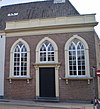
|
| 7th | Muiden | Muiderberg Jewish cemetery | 5.1 | On the Jewish cemetery Muiderberg are around 45,000 Ashkenazi Jews , mainly from Amsterdam , buried. It is the oldest and at the same time the largest Jewish burial place in the Netherlands. Burials were prohibited in Muiderberg during the German occupation. Many graves are no longer tended nowadays because the family members were murdered in the Holocaust. |

|
| 8th | Muiderberg Jewish cemetery | "De Machine" pumping station | 4.2 | The De Machine pumping station was built in 1883 to empty the Naardermeer , which did not succeed. Today it is a residential building. |

|
| 9 | "De Machine" pumping station | Naarden-Bussum train station | 4.7 | Memorial in memory of five Dutch men who were shot by the German occupiers on February 4, 1945. |

|
| 10 | Naarden-Bussum train station | Bussumerheide | 5.6 | The Jewish cemetery is part of the old Bussum cemetery. Mainly Jews from Naarden and Bussum were buried here. There are around 200 tombstones, and several wooden monuments are unusual. There are memorial plaques for murdered Jews on a brick wall. |

|
| 11 | Bussumerheide | Hilversum train station | 5.4 | At the time of the Second World War, five Dutch resistance activists were executed by the Germans on Bussumerheide. The memorial cruis voor verzetsmensen commemorates them |

|
| 12 | Hilversum train station | Loosdrecht | 6.1 | At the Oude Torenlaan there is a memorial with a stone from Mauthausen. This stone was taken from the local quarry by the resistance fighter Bill Minco where he had to work. On May 5, 1970, it was attached to a wall in the Gedenkt te Sterven cemetery . |
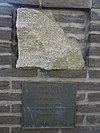
|
| 13 | Loosdrecht | Hilversum Sportpark train station | 7.6 | The war memorial in Nieuw-Loosdrecht commemorates ten men from Loosdrecht who were shot by the German occupiers 50 meters from the memorial site on March 20, 1945, in retaliation for the shooting of a German soldier. |
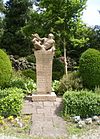
|
| 14th | Hilversum Sports Park train station | Hooge Vuursche | 3.4 | Hooge Vuursche landscape area |
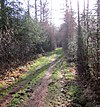
|
| 15th | Hooge Vuursche | Baarn train station | 4.6 | Hooge Vuursche landscape area |

|
| 16 | Baarn train station | Soest | 5.1 | Verzetsmonument Soest . Sculptor Albert Dresmé , built in 1954. In an interview in 1966, the artist said that his own experiences in Amsterdam - such as the deportation of the Jews and the hunger winters of 1944/45 - had inspired his design. After the unveiling of the monument, criticism was raised because a clown can be seen on it, who is supposed to symbolize Joseph Goebbels . |

|
| 17th | Soest | Amersfoort Centraal train station | 5.9 | The Jewish cemetery on Soesterstraatweg in Amersfoort has existed since 1873 and is home to around 3800 graves. Since 1955 there is a plaque commemorating 55 unknown victims from the Amersfoort camp. The dead were first in a mass grave on Leusderheide. Presumably among them are the remains of the Amsterdam local politician Monne de Miranda . |

|
| 18th | Amersfoort Centraal train station | Russian cemetery of honor | 5.3 | In Amersfoort concentration camp some 32,000 people were detained from 1941 to 1945, including "hostages" and " protective custody ". Jewish prisoners were transported to the Mauthausen concentration camp or other concentration camps. People were also executed in the camp. |

|
| 19th | Russian cemetery of honor | Amersfoort Schothorst station | 7.6 | 865 Russian soldiers are buried in the Russian Cemetery of Honor in Leusden . Among them are 101 prisoners of war , mostly of Uzbek origin, of whom 26 were tortured to death in the Amersfoort camp within a few months; the surviving men were executed on April 9, 1942. This was the largest mass execution in the Netherlands during the German occupation. More Soviet prisoners of war and forced laborers were reburied in this cemetery after the war in order to create a central memorial for all Soviet victims. |

|
| 20th | Amersfoort Schothorst station | Amersfoort Vathorst train station | 3.1 | ||
| 21st | Amersfoort Vathorst train station | Nijkerk train station | 6.8 | The de Liver family lived at Spoorstraat 20 in Nijkerk, along with their parents Samuël and Petronella with their daughters Sophia, Margaretha and Josephina. Sophia and Margaretha worked in the psychiatric clinic Het Apeldoornsche Bosch in Apeldoorn. On the night of January 21-22, 1941, the SS cleared the clinic from the Fünten under the leadership of Hauptsturmbannführer Ferdinand . 1200 inmates and 50 employees, including Sophia and Margaretha de Liver, were deported to Auschwitz and murdered. The parents were brought from Westerbork to Sobibor on May 25, 1943 and killed there. Josephina de Liver came to Kamp Vught , where she was assigned to the so-called Philips command . This group was largely protected by the Philips company even after their deportation , which is why Josephina de Liver was the only member of her family to survive the Holocaust. The mayor of Nijkerk, Zwaantinus Bruins Slot, succeeded in hiding so many Jewish people in his community that - after Nijkerk was considered "Jew-free" - there were more Jews than the local Jewish community. |

|
| 22nd | Nijkerk train station | Hoek Tintelersteeg / Hogesteeg | 6.3 | The first Jewish families settled in Nijkerk before 1650. In the 19th century the city made a name for itself as a center for Torah studies, but after the turn of the century the community became smaller and smaller. In 1940/41 the synagogue was closed by the Germans. 48 Jews from Nijkerk were murdered, 13 survived the end of the war. In 1962 the community was given up. The Jews of Nijkerk are remembered in the Nijkerk Museum and with a memorial plaque. |
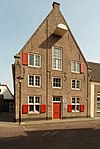
|
| 23 | Hoek Tintelersteeg / Hogesteeg | Putten station | 8.9 | In October 1944, 660 men from Putten were deported by the German Wehrmacht to various concentration camps, most of them to Neuengamme , in retaliation for the bombardment of a car carrying four German officers (one was killed) , where 540 men were deported. Women, children and people had to leave the village, which was then partially destroyed by the Wehrmacht. The Vrouwtje van Putten , which Queen Juliana unveiled in a memorial park in 1949, commemorates this war crime . |
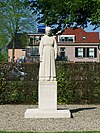
|
| 24 | Putten station | Crossing Volenbekerweg | 4.4 | From 1942 the Kasteel de Vanenburg was used as a prison camp for Jewish slave labor. The men were not allowed to receive visitors or packages. Little information is available about this camp, the only source being postcards from prisoner David Brandon. He was later deported and did not return. |

|
| 25th | Crossing Volenbekerweg | Ermelo train station | 3.3 | ||
| 26th | Ermelo train station | Harderwijk train station | 7.3 | From 1942 the Hillebrandt family from Ermelo offered the Jewish children Eva and Bram Been from Leeuwarden a place to go into hiding. For reasons of space, they were hidden away from their parents separately, so that the children could move around freely. In 1944 they were betrayed and, despite attempts by the Hillebrandt family to save the children's lives, they were deported to Auschwitz. Her parents, who went into hiding in Leeuwarden, survived the war. | |
| 27 | Harderwijk train station | A28 pedestrian bridge | 7.2 | At the beginning of the German occupation 39 Jewish people lived in Harderwijk. Two families of 18 members managed to go into hiding and survived the war. 21 Jewish residents of Harderwijk were deported and murdered. Their names can be read on a plaque on the synagogue. |
|
| 28 | A28 pedestrian bridge | Way over A28 | 5.2 | Hulshorsterzand drift sand area |

|
| 29 | Way over A28 | Nunspeet station | 6.3 | Forest near Nunspeet |

|
| Detour | Vierhouten | Displaced Dorp | 6.1 8.6 |
In 1943 and 1944 there was a "hidden village" (called Pas-Op-Kamp after the nearby Pas Op farm ) in the woods around Vierhouten, made up of nine underground huts, built by Corry (Aunt Cor) and Dionnysiu Bakker (Grandpa Bakker) with the Support of the resistance fighter Edouard von Baumhauer ( De Boem ). Jews, Allied pilots, police officers who did not want to work for the Germans and other persecuted people (80 to 100 in total) were hidden there, including a deserted German soldier. The residents were provided with food by the Bakkers. In October 1944 the village was discovered by accident by German soldiers hunting. Several residents were able to escape, eight of them were shot on the spot. Grandpa Bakker and 45 other men were executed in retaliation in early 1945. Since 2013 you can visit three huts as replicas. |
 
|
| 30th | Nunspeet station | Klaterweg | 5.3 | ||
| 31 | Klaterweg | Station't Harde | 6.3 | ||
| Detour | Elburg | 't Harde | 5.2 5.9 6.6 |
The two Jewish boys Nico (1932) and Loukie (1936) were hidden in Kasteel Zwaluwenburg, it was said that they had been evacuated from Rotterdam. In 1942 the castle was searched by the Dutch Marechaussee , and the two children were sent to Zwolle prison. They were released shortly afterwards and then arrested again. They came to the children's house opposite the Hollandsche Schouwburg , from where they were brought to safety by resistance groups in a foster family. At different addresses in hiding, they survived the war, their parents perished. |
 
|
| 32 | 'T Harde train station | Surroundings Vierschotenweg | 5.4 | ||
| 33 | Surroundings Vierschotenweg | Wezep train station | 7.4 | ||
| 34 | Wezep train station | Hattem , Wachtelenberg | 4.7 | ||
| 35 | Hattem , Wachtelenberg | Hattem , center | 3.8 | The grave of the Van Gelder-Bakker couple from Zwolle is in the Jewish cemetery in Hattem . During the occupation they lived in hiding in a hut on the Molecaten estate , and two other families in hiding lived nearby. They were provided with food by the Landelijke Organizatie voor Hulp aan Onderduikers (LO). The couple were known for their risky behavior and did not follow the agreed rules; so they let their children go outside despite warnings. The temporarily abandoned hut belonging to the van Gelder family was discovered during a tank exercise by the Wehrmacht, but the mayor of Hattem was able to prevent further investigations by the Germans. After this incident, the parents were allowed to return to the hut, but the children were housed elsewhere. The parents insisted that their children be returned to them and arguments broke out. The resistance fighters feared that the couple's behavior was a danger to everyone. On April 22, 1944, members of the resistance group jointly decided that they were executed and buried in the forest. After the war they were reburied in the Jewish cemetery in Hattem. Their children had them put up a tombstone; the names of the couple are also on the plaque on the former synagogue of Hattem. |
 
|
| 36 | Hattem , center | Zwolle train station | 7.9 | On October 2 and 3, 1942, the Jewish labor camps in the Netherlands were evacuated. The families of the forced laborers from Zwolle were asked to report to the Celeanum high school because of alleged "family reunification". On October 3rd, the families were brought from the grammar school to the train station in Zwolle and from there to Westerbork . The majority of the people were murdered in Auschwitz. |

|
| 37 | Zwolle train station | Sparrenlaan / Campherbeeklaan | 4.7 | Jews had lived in Zwolle since the 14th century, and from 1899 they had their own synagogue. In 1940 around 800 Jewish people lived in the city, 140 of whom survived the war in hiding, four of whom returned from camps. Atie and Nico Noordhof's address in hiding was at PC Hooftstraat 18, where a total of 14 people were accommodated in the cellar and in the attic of a terraced house. Zwolle was liberated on April 14, 1945 and the people in hiding were able to leave their hiding place. “That was the happiest moment in our life,” said Nico Noordhof. In 1999 the Noordhofs were posthumously honored as Righteous Among the Nations . |

|
| 38 | Sparrenlaan / Campherbeeklaan | Grensweg | 5.5 | On September 3, 1944, the last transport left Westerbork for Auschwitz. Sonja Wagenaar-van Dam was one of a group of eight young people who managed to cut open the wooden wall of the wagon with the help of a saw smuggled from the warehouse. They managed to jump out of the car and escape. | |
| 39 | Grensweg | Lichtmis | 5.0 | ||
| 40 | Lichtmis | Osterparallelweg / Dekkerweg | 5.0 | Nine-year-old Ed van Thijn and his mother were able to get out of the Westerbork camp through a ruse by their father in early 1943. In the following years, van Thijn hid in 18 different places. He was eventually betrayed and brought back to Westerbork in early 1945. Because of the general strike of 1944, there was no longer any train service, so he was not deported. At the end of the war, the now eleven year old was still in Westerbork. He was appointed to guard the collaborators who were now detained in the camp. His grandparents were murdered and his parents survived the Holocaust. Van Thijn later became Lord Mayor of Amsterdam and Dutch Interior Minister. | |
| 41 | Osterparallelweg / Dekkerweg | Staṕhorst , Bergerslag | 6.1 | From July 10, 1942, 96 Jewish forced laborers were housed in the Het Wiede Gat labor camp, who had to work on the construction of a forest in the surrounding heath area. On October 2, 1942, the camp, like others, was evacuated and the workers were brought to Westerbork; her family also came to Westerbork as part of an alleged "family reunification" (see stage 36); from there most of them were deported to Auschwitz. | |
| 42 | Staṕhorst , Bergerslag | Meppel station | 6.5 | In 1948 the war memorial was inaugurated on the Staphorst market. Among the names on the memorial are those of Emmanuel Roos and his nephew Salomon van der Sluis. In 1942 the two men had to register for forced labor. Salomon was sent to the Linde labor camp near Zuidwolde and his uncle Emmanuel to the Conrad camp near Staphorst. Both did not return. |

|
| 43 | Meppel station | Oosterbroekenweg | 4.1 | Eduard van de Rhoer came to the Westerbork transit camp in 1942 and was assigned to the kitchen with the help of the non-Jewish cook Dirk Massier from Meppel . Because of his work, he was temporarily exempted from deportation and was able to offer them a certain protection when his parents and brother came to the camp a few months later. Nevertheless, on May 4, 1943, his parents were deported. A week later Eduard was able to help his brother Jacques to escape and then to flee himself. The two brothers met again at an address in hiding. They survived the end of the war. Her parents' names are on the Jewish monument in Meppel. |

|
| 44 | Oosterbroekenweg | Noorderkanalweg / Broekhuizen | 3.2 | ||
| 45 | Noorderkanalweg / Broekhuizen | Koekange | 5.0 | ||
| 46 | Koekange | Real ones | 5.9 | ||
| 47 | Real ones | Hoogeveen , Nieuwe Brug | 3.5 | In August 1942, Cornelis Flokstra took three people into hiding in his home. After a raid on October 2, 1942, another six people were taken into the small 20 square meter room, hidden under hay. In March there was a five-hour house search by 17 members of the order police , but they did not find anything. A short time later, Flokstra took in four other persecuted people. All survived the war. In 1967 the couple was honored as Righteous Among the Nations . A memorial stone commemorates them near the family's farm. |

|
| 48 | Hoogeveen , Nieuwe Brug | Hoogeveen train station | 5.6 | On October 2, 1942, a large raid took place in Hoogeveen, during which 165 Jewish people were picked up and brought to a café on the market square. From there they were deported to the camp in Westerbork. |

|
| 49 | Hoogeveen train station | Secteweg | 5.0 | In the summer of 1943, the German occupiers executed five men from Hoogeveen in the Sparbankbosch in retaliation for the killing of three members of the NSB who were considered criminals. Three of those executed in the Sparbankbosch were members of the resistance, two were Jews. To commemorate these men, a monument consisting of five large metal figures was unveiled in the local forest in 2003. Crosses and stars of David on the figures symbolize the fatal bullet holes. The accompanying text reads: “Ook vandaag, terwijl u hier sta, en dit leest, wordt elders iemand verkracht, gemarteld vermoord, omdat hij zich verzet, omdat ze vrouw is, of vanwege de kleur van huid of hart.” While you are standing here reading this, someone else is being raped, tortured, murdered for resisting, for being a woman, or for the color of his skin or his heart. " |

|
| 50 | Secteweg | Kreembong, Tiendeveen | 6.0 | ||
| 51 | Kreembong, Tiendeveen | De Blinkerd | 6.3 | At the beginning of 1942 a large group of Jewish men were transferred from Amsterdam to the Kreembong labor camp. At first, the situation was bearable as there was enough food. That changed in July 1942, when more men came from other camps, as supplies deteriorated and the men learned of the raids in Amsterdam. The camp was probably closed shortly afterwards and the inmates were most likely deported. On April 23, 2009, a memorial stone was unveiled in the presence of two former camp inmates. | |
| 52 | De Blinkerd | Wijster | 4.1 | De Blinkerd observation tower |

|
| 53 | Wijster | Hatching | 6.3 | ||
| 54 | Hatching | Orange Canal | 5.4 | Jews lived in Beilen from the end of the 18th century, and the synagogue was inaugurated in 1885. In 1941 the Jewish community of Beilen numbered 64 people, of whom only one survived the Holocaust, despite multiple attempts by the mayor at the time to save them from deportation. |
|
| 55 | Orange Canal | Hooghalen | 4.9 | The Orange Canal was used to supply the Westerbork camp with food and building materials by ship. Also shipped were the wrecks of downed Allied planes, which were dismantled by the prisoners in Westerbork for recycling. |

|
| 56 | Hooghalen | Westerbork transit camp | 5.3 | In the summer of 1942 the railway line to Westerbork was built, it formed a branch of the line from Beilen to Assen . The first transport directly from here in the direction of Auschwitz went in November 1942, until that time the prisoners had to go to Hooghalen on foot. By September 1944, more than 100,000 Jewish people had been deported to extermination camps and murdered from here. On April 12, 1945, the camp, in which there were still around 900 people, was liberated by Canadian soldiers. In 1983 a memorial center was opened near the former camp. On the former roll call square there are De 102,000 stenen (The 102,000 Stones) , each of them symbolizing a murdered person. |
 
|
literature
- Wandelnet (Ed.): Westerborkpad. Wandelen in the Spoor van de Jodenvervolging . Amersfoort 2017, ISBN 978-94-92641-00-7 . - The additional texts in the table are based on the information in this book, unless other evidence is given.
Web links
- Westerborkpad. In: wandel.nl. March 19, 2017, accessed January 22, 2018 (Dutch).
- Westerborkpad. In: kampwesterbork.nl. Retrieved April 21, 2018 (Dutch).
- Marking route. In: kampwesterbork.nl. Retrieved April 21, 2018 (Dutch).
- Achtergrond. In: kampwesterbork.nl. Retrieved April 21, 2018 (Dutch).
Individual evidence
- ↑ a b Westerborkpad laat ons de oorlog nooit vergeten. nieuws.nl, September 10, 2017, accessed on April 21, 2018 .
- ↑ Wandelen over het Westerborkpad. In: drentheindeoorlog.nl. Retrieved April 22, 2018 .
- ↑ Westerbork Luisterpad. In: westerborkluisterpad.nl. May 13, 2010, accessed April 21, 2018 .
- ↑ Geschiedenis -. In: synagogeweesp.nl. Retrieved April 20, 2018 (Dutch).
- ^ De Machine. In: tgooi.info. Retrieved April 20, 2018 (Dutch).
- ↑ Mauthausen-steen. In: regionalebronnenbank.nl. Retrieved April 20, 2018 (Dutch).
- ↑ Hooge Vuursche - IVN. In: ivn.nl. Retrieved April 20, 2018 (Dutch).
- ^ Monument Soest. In: Comité 4 en 5 mei. Retrieved April 24, 2018 .
- ↑ Het Ereveld - Stichting Russian Ereveld. In: russisch-ereveld.nl. November 18, 1948, accessed April 20, 2018 (Dutch).
- ↑ October 2, 1944 - De mannen van Putten was moved away. In: vandaagindegeschiedenis.nl. October 2, 2017, accessed April 20, 2018 (Dutch).
- ↑ Madelon de Keizer: Raid in Putten. Wehrmacht crimes in a Dutch village . Dittrich, Cologne 2001, ISBN 3-920862-35-X .
- ↑ Peter Yska: Gevonden brieven onthullen Joods drama in 1944 in Ermelo. (PDF) Retrieved April 21, 2018 . (PDF file)
- ^ Joodse gemeenschap. In: Mijn Gelderland. Retrieved April 21, 2018 (Dutch).
- ↑ Verscholendorp> Het onderduikerskamp> Het verhaal van het Verscholen Dorp. In: verscholendorp.eu. Retrieved April 21, 2018 (Dutch).
- ↑ Verscholen Dorp in Vierhouten. In: go2war2.nl. Retrieved April 22, 2018 (Dutch).
- ↑ Gezin Abraham van Gelder. In: joodsmonument.nl. April 22, 1944, accessed April 21, 2018 (Dutch).
- ↑ Hilke Vos: Op dit Zwolse adres zaten tijdens de Tweede Wereldoorlog 14 (!) Onderduikers. In: indebuurt.nl. October 10, 2017, accessed April 21, 2018 (Dutch).
- ↑ Zaagje redde vangene kamp Westerbork. In: nos.nl. April 12, 2015, accessed April 21, 2018 (Dutch).
- ↑ Ed van Thijn. In: Bevrijdingsportretten. Retrieved April 21, 2018 (Dutch).

